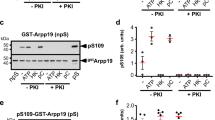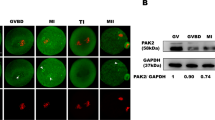Abstract
In eukaryotes, entry into M-phase of the cell cycle is induced by activation of cyclin B–Cdc2 kinase. At G2-phase, the activity of its inactivator, a member of the Wee1 family of protein kinases, exceeds that of its activator, Cdc25C phosphatase. However, at M-phase entry the situation is reversed, such that the activity of Cdc25C exceeds that of the Wee1 family. The mechanism of this reversal is unclear. Here we show that in oocytes from the starfish Asterina pectinifera, the kinase Akt (or protein kinase B (PKB)) phosphorylates and downregulates Myt1, a member of the Wee1 family. This switches the balance of regulator activities and causes the initial activation of cyclin B–Cdc2 at the meiotic G2/M-phase transition. These findings identify Myt1 as a new target of Akt, and demonstrate that Akt functions as an M-phase initiator.
This is a preview of subscription content, access via your institution
Access options
Subscribe to this journal
Receive 12 print issues and online access
$209.00 per year
only $17.42 per issue
Buy this article
- Purchase on Springer Link
- Instant access to full article PDF
Prices may be subject to local taxes which are calculated during checkout






Similar content being viewed by others
References
Nurse, P. Universal control mechanism regulating onset of M-phase. Nature 344, 503–508 (1990).
Nigg, E. A. Mitotic kinases as regulators of cell division and its checkpoints. Nature Rev. Mol. Cell Biol. 2, 21–32 (2001).
Coleman, T. R. & Dunphy, W. G. Cdc2 regulatory factors. Curr. Opin. Cell Biol. 6, 877–882 (1994).
Lew, D. J. & Kornbluth, S. Regulatory roles of cyclin dependent kinase phosphorylation in cell cycle control. Curr. Opin. Cell Biol. 8, 795–804 (1996).
Sagata, N. Meiotic metaphase arrest in animal oocytes: its mechanisms and biological significance. Trends Cell Biol. 6, 22–28 (1996).
Jaffe, L. A., Gallo, C. J., Lee, R. H., Ho, Y.-K. & Jones, T. L. Z. Oocyte maturation in starfish is mediated by the βγ-subunit complex of a G-protein. J. Cell Biol. 121, 775–783 (1993).
Sadler, K. C. & Ruderman, J. V. Components of the signaling pathway linking the 1-methyladenine receptor to MPF activation and maturation in starfish oocytes. Dev. Biol. 197, 25–38 (1998).
Kishimoto, T. Cell cycle arrest and release in starfish oocytes and eggs. Seminars Cell Dev. Biol. 9, 549–557 (1998).
Kishimoto, T. Activation of MPF at meiosis reinitiation in starfish oocytes. Dev. Biol. 214, 1–8 (1999).
Datta, S. R., Brunet, A. & Greenberg, M. E. Cellular survival: a play in three Akts. Genes Dev. 13, 2905–2927 (1999).
Vanhaesebroeck, B. & Alessi, D. R. The PI3K-PDK1 connection: more than just a road to PKB. Biochem. J. 346, 561–576 (2000).
Scheid, M. P. & Woodgett, J. R. PKB/AKT: Functional insights from genetic models. Nature Rev. Mol. Cell Biol. 2, 760–768, (2001).
Mueller, P. R., Coleman, T. R., Kumagai, A. & Dunphy, W. G. Myt1: a membrane-associated inhibitory kinase that phosphorylates cdc2 on both threonine-14 and tyrosine-15. Science 270, 86–90 (1995).
Okano-Uchida, T. et al. In vivo regulation of cyclin A/Cdc2 and cyclin B/Cdc2 through meiotic and early cleavage cycles in starfish. Dev. Biol. 197, 39–53 (1998).
Kanatani, H., Shirai, H., Nakanishi, K. & Kurokawa, T. Isolation and identification of meiosis inducing substance in starfish. Nature 221, 273–274 (1969).
Picard, A., Labbe, J. C., Barakat, H., Cavadore, J. C. & Doree, M. Okadaic acid mimics a nuclear component required for cyclin B-cdc2 kinase microinjection to drive starfish oocytes into M phase. J. Cell Biol. 115, 337–344 (1991).
Okumura, E., Sekiai, T., Hisanaga, S., Tachibana, K. & Kishimoto, T. Initial triggering of M-phase in starfish oocytes: a possible novel component of maturation-promoting factor besides cdc2 kinase. J. Cell Biol. 132, 125–135 (1996).
Nakajo, N. et al. Absence of Wee1 ensures the meiotic cell cycle in Xenopus oocytes. Genes Dev. 14, 328–338 (2000).
Kumagai, A. & Dunphy, W. G. Purification and molecular cloning of plx1, a cdc25-regulatory kinase from Xenopus egg extracts. Science 274, 1377–1380 (1996).
Qian, Y.-W., Erikson, E., Li, C. & Maller, J. L. Activated polo-like kinase Plx1 is required at multiple points during mitosis in Xenopus laevis. Mol. Cell. Biol. 18, 4262–4271 (1998).
Glover, D. M., Hagan, I. M. & Tavares, A. A. M. Polo-like kinases: a team that plays throughout mitosis. Genes Dev. 12, 3777–3787 (1998).
Nigg, E. A. Polo-like kinases: positive regulators of cell division from start to finish. Curr. Opin. Cell Biol. 10, 776–783 (1998).
Qian, Y.-W., Erikson, E., Taieb, F. E. & Maller, J. L. The polo-like kinase Plx1 is required for activation of the phosphatase Cdc25C and cyclin B-Cdc2 in Xenopus oocytes. Mol. Biol. Cell 12, 1791–1799 (2001).
Palmer, A., Gavin, A. C. & Nebreda, A. R. A link between MAP kinase and p34cdc2/cyclin B during oocyte maturation: p90rsk phosphorylates and inactivates the p34cdc2 inhibitory kinase myt1. EMBO J. 17, 5037–5047 (1998).
Nebreda, A. R. & Gavin, A. C. Cell survival demands some Rsk. Science 286, 1309–1310 (1999).
Tachibana, K., Machida, T., Nomura, Y. & Kishimoto, T. MAP kinase links the fertilization signal transduction pathway to the G1/S-phase transition in starfish eggs. EMBO J. 16, 4333–4339 (1997).
Tachibana, K., Tanaka, D., Isobe, T. & Kishimoto, T. c-Mos forces the mitotic cell cycle to undergo meiosis II to produce haploid gametes. Proc. Natl Acad. Sci. USA 97, 14301–14306 (2000).
Andersen, C. B., Roth, R. A. & Conti, M. Protein kinase B/Akt induces resumption of meiosis in Xenopus oocytes. J. Biol. Chem. 273, 18705–18708 (1998).
Zhou, B. P. et al. Cytoplasmic localization of p21Cip1/WAF1 by Akt-induced phosphorylation in HER-2/neu-overexpressing cells. Nature Cell Biol. 3, 245–252 (2001).
Leighton, I. A., Dalby, K. N., Caudwell, F. B., Cohen, P. T. W. & Cohen, P. Comparison of the specificities of p70 S6 kinase and MAPKAP kinase-1 identifies a relatively specific substrate for p70 S6 kinase: the N-terminal kinase domain of MAPKAP kinase-1 is essential for peptide phosphorylation. FEBS Lett. 375, 289–293 (1995).
Fisher, D. L., Brassac, T., Galas, S. & Doree, M. Dissociation of MAP kinase activation and MPF activation in hormone-stimulated maturation of Xenopus oocytes. Development 126, 4537–4546 (1999).
Gross, S. D. et al. The critical role of the MAP kinase pathway in meiosis II in Xenopus oocytes is mediated by p90Rsk. Curr. Biol. 10, 430–438 (2000).
Posner, B. I. et al. Peroxovanadium compounds: A new class of potent phosphotyrosine phosphatase inhibitors which are insulin mimetics. J. Biol. Chem. 269, 4596–4604 (1994).
Lemaire, P., Garrett, N. & Gurdon, J. B. Expression cloning of Siamois, a Xenopus homeobox gene expressed in dorsal-vegetal cells of blastulae and able to induce a complete secondary axis. Cell 81, 85–94 (1995).
Kishimoto, T. Microinjection and cytoplasmic transfer in starfish oocytes. Methods Cell Biol. 27, 379–394 (1986).
Boyle, W. J., van der Geer, P. & Hunter, T. Phosphopeptide mapping and phosphoamino acid analysis by two-dimensional separation on thin-layer cellulose plates. Methods Enzymol. 201, 110–149 (1991).
Acknowledgements
We thank K. Ohsumi, S. Hisanaga and T. Saito for suggestions, L. A. Jaffe and M. Terasaki for critical reading of the manuscript and particularly Y. Kaziro of Shelling-Plau Laboratory of Molecular Medical Science for initiating this study. This work was supported by grants from the Ministry of Education, Science and Culture, Japan, the Human Frontier Science Program, and the Core Research for Evolutional Science and Technology (CREST) of the Japan Science and Technology Corporation to T.K.
Author information
Authors and Affiliations
Corresponding author
Rights and permissions
About this article
Cite this article
Okumura, E., Fukuhara, T., Yoshida, H. et al. Akt inhibits Myt1 in the signalling pathway that leads to meiotic G2/M-phase transition. Nat Cell Biol 4, 111–116 (2002). https://doi.org/10.1038/ncb741
Received:
Revised:
Accepted:
Published:
Issue Date:
DOI: https://doi.org/10.1038/ncb741
This article is cited by
-
Cell cycle regulation by ADP and IGF-1 in cultured late developing glia progenitors of the avian retina
Purinergic Signalling (2023)
-
Functional role of AKT signaling in bovine early embryonic development: potential link to embryotrophic actions of follistatin
Reproductive Biology and Endocrinology (2018)
-
Entry into mitosis: a solution to the decades-long enigma of MPF
Chromosoma (2015)
-
A potential anti-tumor herbal medicine, Corilagin, inhibits ovarian cancer cell growth through blocking the TGF-β signaling pathways
BMC Complementary and Alternative Medicine (2013)
-
The CDK1 inhibitory kinase MYT1 in DNA damage checkpoint recovery
Oncogene (2013)



